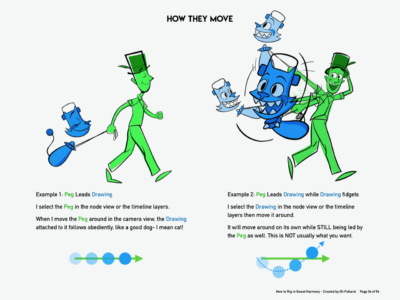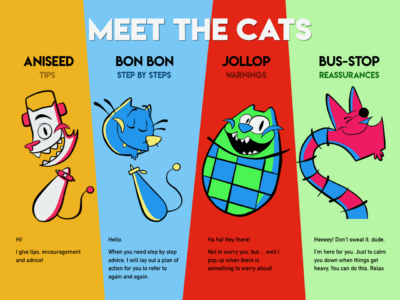Cat Class – A Toon Boom Tutorial Series by Oli Putland – Interview
Animation software is big business with many companies vying to become the “industry standard” bit of kit for animation production.
One of the big players jostling to get on top of the pile is Toon Boom Harmony, which boasts plenty of clients worldwide with the likes of Pony by Blue Zoo, Powerbirds by Brown Bag Films and Doctor Who – The Macra Terror by Sun & Moon Studios making up just three of the many projects and companies the software finds itself being used for in the UK alone.
We all know that in the hands of a professional, software can look really easy to use, but beginners can find traversing the interface rather baffling, even with the help of hundreds of different tutorial videos by different authors available online. Step forward Oli Putland, himself an animator who has created an accessible and easy guide that promises to introduce and allow users to experience Harmony through an easy to understand model. In Cat Class – How to Rig, Putland takes us through the basics of the Rigging Techniques in Harmony, the first of what could be many guides to help people navigate their way through Nodes, Auto Patches, Pegs, Drawings and more.
As one of Toon Boom’s appointed “ambassadors“, people who the firm recognise as users who advance animation using Harmony or Storyboard Pro, Oli’s guide supplements the video tutorials available on the Toon Boom website which aid the user in understanding what they need to know to use the software. Oli has created this manual in his are time and made this knowledge available to his Patreons who can subscribe to his page for the illustrated tutorial.
As a little treat Oli has kindly set up a preview for his guide especially for Skwigly readers, you can preview the guide by clicking here
We caught up with Oli to find out about the guide and his career in animation.
Tell us a little about your animation background.
I started my career while studying at the BRIT performing arts & technology school- The one that Adele and Tom Holland and various other well-to-do performers went to. They were so supportive, and allowed me to study this fancy ‘Animation’ thing way earlier than anyone else I’ve met before or since.
Since then, I’ve worked as a stop motion animator on various Aardman productions such as Shaun the Sheep and Timmy Time as well as Postman Pat, Fifi & the Flowertots & Pingu at Cosgrove Hall and HOT Animation.
I’ve also worked as a 2D animation director for the Beano and recently worked with Sun & Moon productions as a Lead Rigger on Doctor Who – The Macra Terror.
You’re a bit of an animation polymath but have made the move from stop motion to 2D, do you have a preferred medium?
Each has a super power that the other doesn’t- Stop-motion has lighting, camera work and a presence which 2D doesn’t. Conversely 2D can stretch character design and movement ideas to a degree stop-mo can’t usually manage.
So long as the production utilises the medium in an interesting way, I’m happy!
You’ve developed a knack for Toon Boom, what is it you find appealing about the software?
I love the fact I can come up with pretty much any idea and make something which looks absolutely 100% as I envisioned it very quickly. And animating using Harmony is an absolute joy as I can lose myself in the acting.
You recently worked with YouTube Animator Harry Partridge’s Killgar to test a Master Controller Rig, one of the more complex Toon Boom rigs, tell us how you accomplished that.
I’m friends with Harry and he’d once asked me if there were any ways of improving the efficiency of making high quality cartoons that look and feel as close to the traditional techniques as possible.
I’d come fresh from The Macra Terror which was using some pretty avant-garde rigging techniques, some of which even Toon Boom themselves hadn’t thought of, and wanted to fiddle with some more techniques which I hadn’t the time to experiment with on such a tight schedule.
Killgar was the result and Harry and I learnt quite a bit from the experience. Toon Boom had improved many of the issues Sun and Moon and I faced since Macra, with version 16 and it was very gratifying to figure out a more robust modus operandi to work from going forward.
You’ve produced a users guide, is this something you feel is missing from the market?
I wrote this because when I was learning the software years ago, there wasn’t anything that really spoke to me in the ways I would have liked.
Toon Boom themselves are super supportive and lovely bunch of people. They are always there to give the odd bit of advice to anyone when they’re really stuck, but learning the software from scratch- there didn’t seem to be any… ‘bible’ to go and read with practical tips from someone who uses the software in a more ‘in the trenches’ kind of a way.
In fact, I ended up making up own fancy notes which I still refer to every so often, now!
A book which seems to have unconsciously influenced me when making the Guide was ‘The Animator’s Survival Kit’ by the late great Richard Williams. There were tips in his book which even as an animator of 25 years I was learning from anew- largely due to his frank, conversational style and playful, clear illustrations.

You’ve made the book fun and accessible, utilising characters that you created, tell us more about the design and “The Cats”
I wanted the book to be fun to look at, as well as to read.
The Cats (Aniseed, Bon bon, Jollop & Bus Stop) are brightly coloured and fun designs but they also represent different types of information: Tips, Step by step, Warnings & Reassurance. They give an otherwise dry piece of information humour and humanity- vital when you’re learning something technical I think!
The only non cat characters that make appearances are Julio- a fairly standard human character, and me! In fact, if it weren’t your suggestion on Twitter to draw a man leading a dog around to illustrate the Peg/Drawing dynamic, I may not have made an appearance in the guide at all! Thanks for that.

Why are you making the Guide on Patreon?
Figuring out how to survive in the crazy, shifting sands world of YouTube is a chore and it changes on an almost daily basis, so using Patreon as a means of consolidating the means of income by allowing people to buy ‘What-you-do-whatever-that-may-be’, has allowed me to branch off and make something that isn’t strictly a video, although I did make a quick animated video advert for the guide to make You-tubers who aren’t necessarily interested, giggle a bit.
If anyone is interested in obtaining the guide go to www.Patreon.com/oli.


